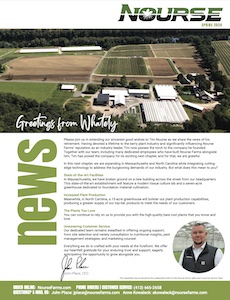How to Grow Brambles
Raspberries and Blackberries
PLANTING
If the soil is not well-drained, raise the soil height of the planting rows or build 12–18 inches wide raised beds.
Plant as soon as possible in the spring, after your soil has warmed to 50°F. Planting too early, in cool, damp soil can delay development or cause roots to rot. Do not fertilize at planting. Planting at the correct depth is important. Your planting rows should be measured and maintained at no more than a 12–18 inches width.
When planting dormant, bare-root plants, use a hoe to make a two-inch deep trench the length of the bed. Lay the roots horizontally along the trench, two inches deep. You may need to position some canes deeper than two inches so that all roots on the cane are covered, still laying the length of the roots parallel to the soil surface at the two-inch depth. Cover them immediately. The fine root system should not be allowed to dry out during the planting process, which can happen very quickly on a warm day. CAUTION: If set too deeply, they will not easily send up new canes from the root as they must.
Plant tissue culture plugs one-half to one inch deeper than the soil level of the plant.
PLANTING YEAR
New growth may not appear for five to six weeks. The cane portion of the plant may never lead out; expect most, if not all new growth to come from the roots. If you want to check for root development after six to seven weeks, dig very gently two to three inches away from the cane. Be careful not to damage delicate new sprouts that have not yet broken the soil surface. If the plants are not leafing out or sprouting new growth from the roots after seven to eight weeks, call us.
IRRIGATION
Water thoroughly after planting and maintain good soil moisture until plants are well established. The plants should then receive one to two inches of rainfall or the equivalent each week throughout the season. Do not water every day – one to three times per week is sufficient.
FERTILIZATION
You may thoroughly incorporate a light amount of fertilizer at least 2 weeks prior to planting. Do not fertilize when planting, wait until new transplants are well established. For optimum growth and production, home gardeners should apply ½ lb. – ¾ lb. of 10-10-10 fertilizer per 100 sq. ft. each spring and an additional 1 lb. of 10-10-10 fertilizer per 100 sq. ft. in mid-summer. Do not fertilize after July 1st, as late fertilization generates tender new growth which will be more susceptible to winter injury.
Commercial growers should use 500 lbs. of 10-10-10 per acre or make applications according to soil tests. Additional applications may be necessary according to weather and/or leaching conditions.
TISSUE CULTURE BRAMBLE PLANTS
PLANTING
- Cover the soil plug with ½”-1” of soil, using the same spacing as bare root plants.
- Fertilize TC plug plants the same as bare-rooted plants using ½ lb.-3/4 lb. of 10-10-10 per 100 sq. ft. incorporated at least 2-3 weeks prior to planting or wait until plants are well established and then side-dress with 10-10-10 to maintain vigorous growth.
- Irrigate well after planting. Maintain good moisture levels until the plants are well established or for four to six weeks.
- Use care when applying herbicide on TC plants. We have had good results using 4 lbs. per acre of Devrinol 50W. In our experience, other herbicides will damage these plants.
RASPBERRY PLANTS QUICK REFERENCE
Spacing
- 18–24 inches for reds and yellows; 20–24 inches for blacks.
- Recommend 8–12 feet between rows depending on the machinery.
Irrigation
- Soak in water using Agri-gel™ for one to two hours before planting (except for tissue culture plugs).
- Water thoroughly after planting.
- One to two inches of rainfall or equivalent per week.
Fertilization
- Before planting add ½–¾ pounds of 10–10–10 per 100 square feet.
- Commercial growers should use 500 pounds per acre.
- An additional one pound of 10–10–10 per 100 square feet can be applied in July or August and in early spring in the following years.
- pH: 6.0–6.5.
Weed Control
- Regular cultivation is necessary during the growing season.
- Roots are shallow—don’t cultivate more than an inch deep.
- Mulching during establishments can help control weeds.
- Contact a local extension for chemical recommendations.
Trellis
- We suggest plants are supported by a T-trellis.



